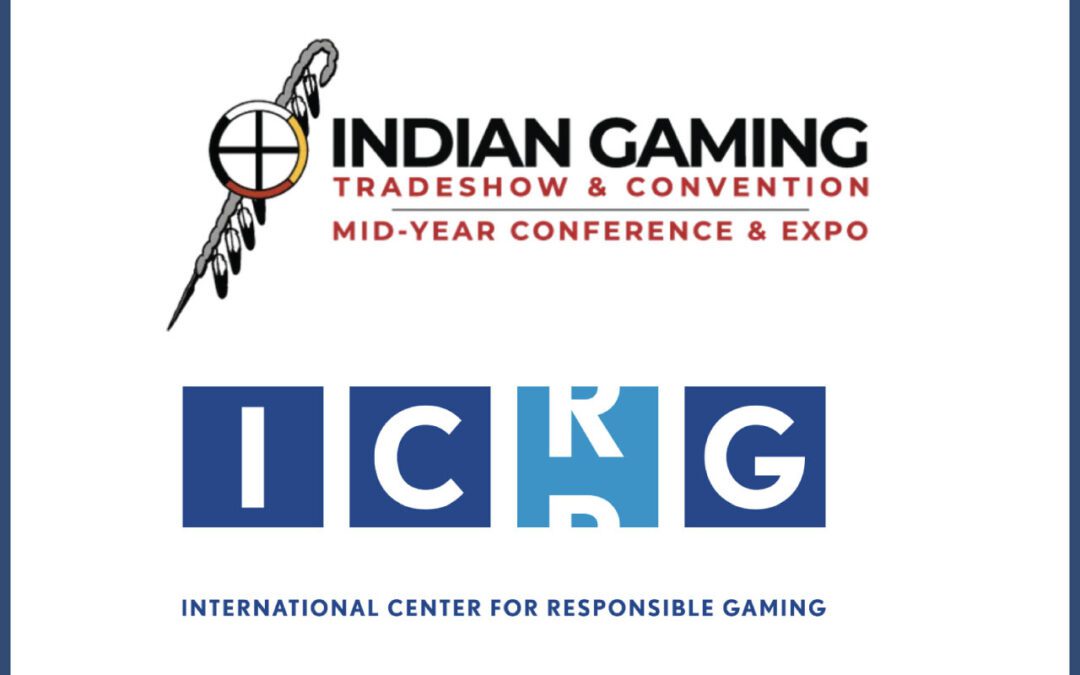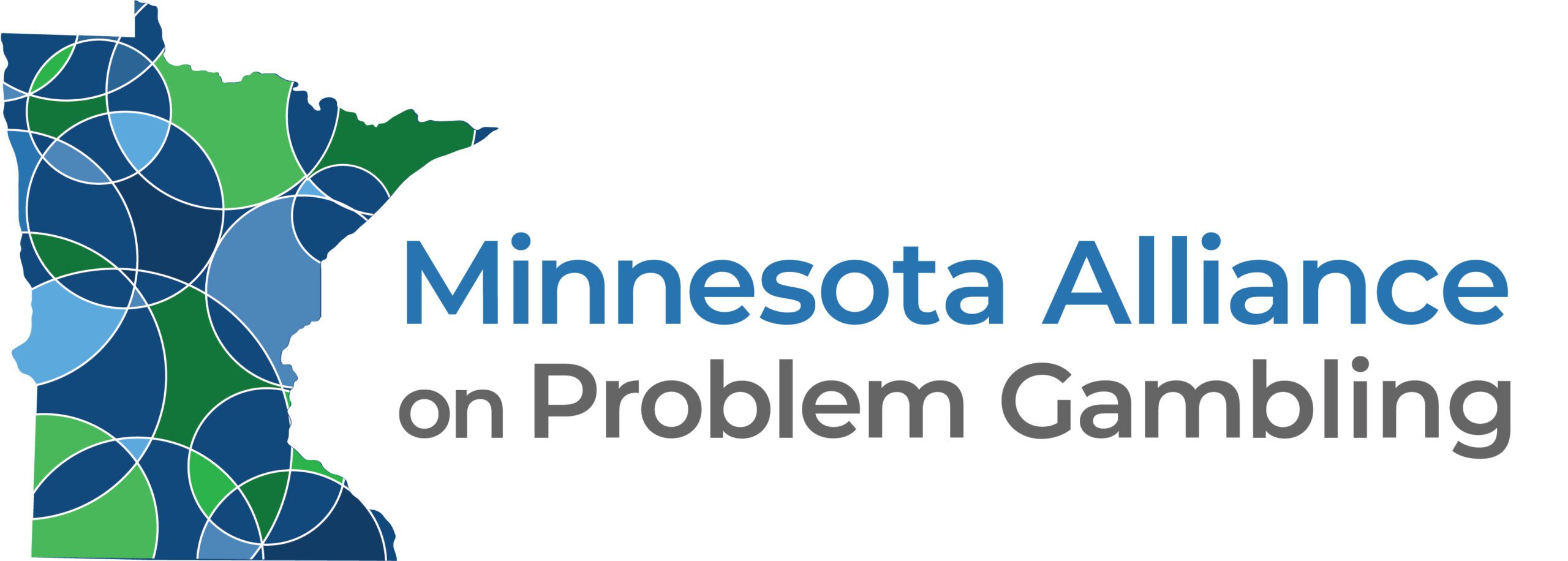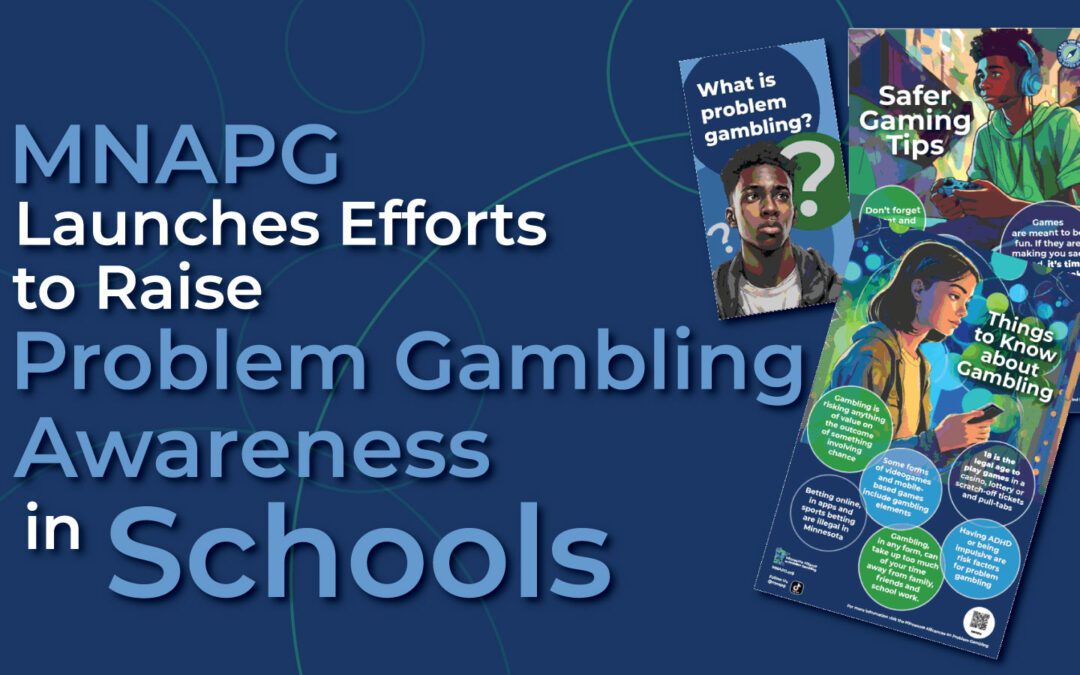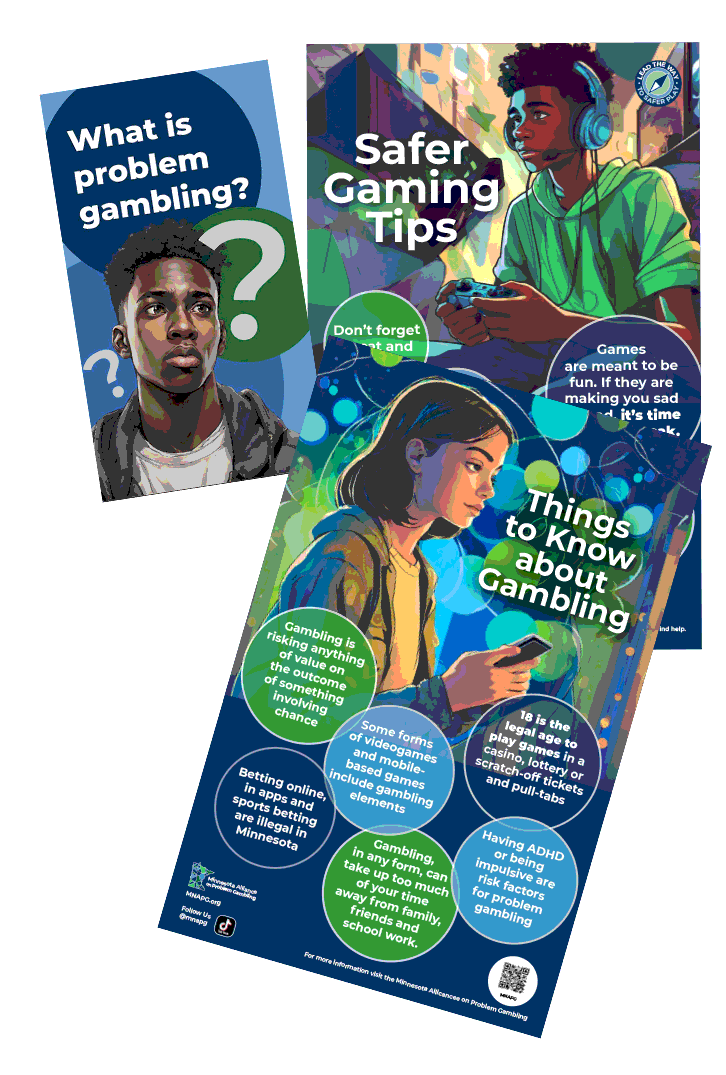
Dec 17, 2025 | ABOUT MNAPG, ADVOCACY, PROFESSIONALS, YOUTH GAMBLING
MNAPG attended two conferences in October: the mid-year Indian Gaming Association (IGA) conference and the International Center for Responsible Gaming (ICRG) conference. Here are some takeaways.
Indian Gaming Association Conference
At the IGA, the focus was on the growing concern about prediction markets and casino sweepstakes—and the impact these unregulated, untaxed platforms could have on tribal revenues. Legalized gambling, whether you agree with it or not, has allowed Minnesota tribal nations to expand and diversify their economies and provide a wide range of services to their communities. These market disrupters are viewed as existential threats to tribal sustainability and independence. (Editor’s note: As of November 5, 2025, the Minnesota Attorney General’s office sent cease-and-desist letters to 14 illegal gambling operators—sports betting and casino sweepstakes.)
The American Gaming Association also recognizes the threats these new platforms pose—not only to gambling revenue but also to consumer protection. Our current federal anti-regulatory environment could significantly change how people engage with gambling. By redefining gambling as a commodity and placing it under the Commodity Futures Trading Commission (CFTC), these platforms may create a stronger illusion of control—skill rather than luck. This illusion is a common fallacy among gamblers, especially sports bettors. Mislabeling gambling products as “trading” blurs the line between investing and gambling, putting consumers at risk. The way these platforms target young adults is particularly troubling. They are designed for continuous, habit-forming engagement, with no guardrails or risk warnings.
The discussions were sobering and, for MNAPG, highlighted yet another area where we need to pay close attention and raise awareness within the community and among policymakers.
International Center for Responsible Gaming Conference
The ICRG conference, a day and a half of research reveals, provided an opportunity to hear firsthand the latest findings in responsible gambling, explore emerging tools and regulatory practices, and discuss the growing integration of responsible gambling principles into the broader gambling landscape. While much work remains, I’m encouraged by the shift among some operators to place greater emphasis on consumer protection. Our advocacy efforts at the national and state levels are having a positive impact, and we need to continue being the thorn in operators’ sides.
One session examined the connection between gambling literacy and financial literacy and the need to evolve both so that users understand how risky behaviors can develop through new mediums like digital finance, investment platforms and social media.
Another session focused on artificial intelligence and emphasized that AI should amplify human insight, not replace it. Advances in AI may eventually enhance early risk detection and enable personalized responsible gambling interventions—but only if we eliminate bias and uphold the highest standards of privacy protection.
Finally, researchers studying youth emphasized the need to create relatable prevention materials and deliver them in the spaces where young people actually spend their time, rather than where we think they should be. They also highlighted the importance of developing prevention programs that account for gender, age and cultural identity.

Nov 26, 2025 | PROBLEM GAMBLING, YOUTH GAMBLING
Read the original article on the BASIS here.
By Kira Landauer, MPH
Livestreaming is a popular form of digital entertainment that allows viewers to watch content online as it happens live. Gambling livestreams are popular on platforms like Twitch and TikTok Live, where streamers broadcast themselves gambling with real money and in real time—playing games like online slots or placing sports bets. Audiences can watch the gameplay, listen to the streamer’s commentary, and interact directly with both the streamer and other viewers. What may seem like harmless fun could be problematic for some, with research linking gambling livestream viewership to future gambling intentions and problem gambling. This week, as part of our Special Series on Addiction and Technology, The WAGER reviews a study by Chelsea Hughes and colleagues that examined young adults’ experiences with and perceptions of gambling livestreaming.
What were the research questions?
(1) What motivates young adults to watch and engage with gambling livestreams? (2) How do they perceive their livestream viewing experiences?
What did the researchers do?
The researchers conducted semi-structured interviews with 15 young adults (ages 18 to 24) in the U.K. who regularly watched gambling livestreams (at least once a week) and had gambled in the past year. Participants described their reasons for watching, how they engaged with the livestreams, and their experiences as a viewer. Using thematic analysis, the researchers identified themes related to the meaning and value viewers attributed to their experiences.
What did they find?
The researchers identified three themes (see Figure).
- Social experiences and vicarious excitement describes the parasocial bonds viewers formed with streamers. Even as observers, viewers felt they were sharing in the streamer’s risk-taking and excitement, which created a sense of emotional connection. Many watched not only for gambling content but because they enjoyed the streamer’s personality.
- Interactivity and building loyalty highlights how livestream features—like gamified loyalty (earning points for engaging with the stream) and interactive prediction tools (wagering points on outcomes)—encouraged viewers to participate and feel more invested in the livestream’s outcomes.
- The urge and harm paradox reflects how participants viewed livestreams as a safer way to manage gambling urges, even though watching sometimes intensified those same urges. Some reported that watching livestreams contributed to an increase in their own gambling participation, despite recognizing the influence of streamers’ deceptive marketing tactics.
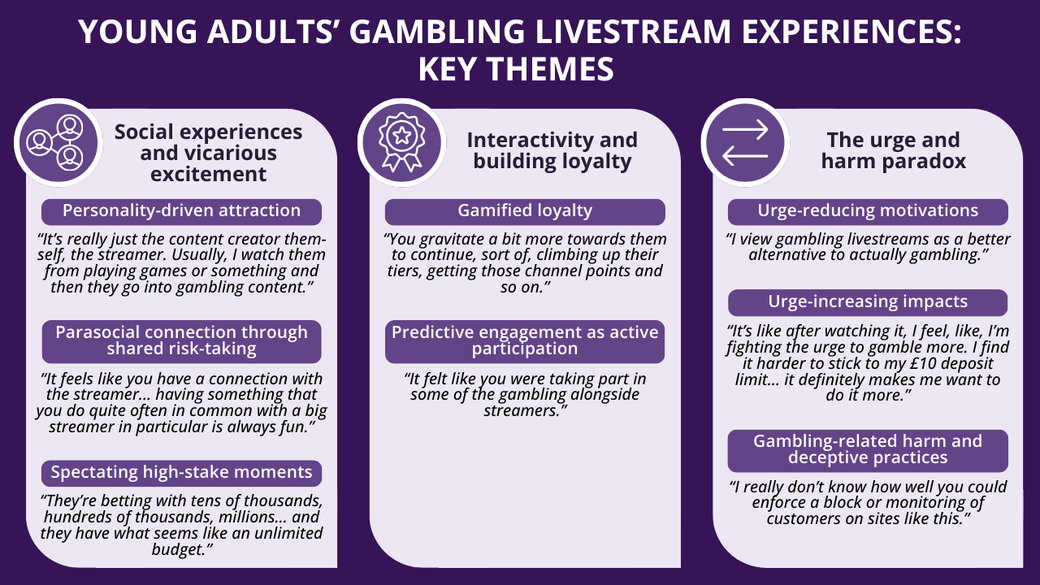
Figure. Key themes from young adults’ gambling livestream viewership, with quotes highlighting each subtheme. Click image to enlarge.
Why do these findings matter?
These findings show that young adults are drawn to gambling livestreams for various, often intertwined, reasons. Many viewers feel a personal connection to their favorite streamers. This sense of social connection and community is enhanced by interactive, gamified livestream features that encourage viewer engagement. These findings can inform regulatory policies intended to reduce potential harms. For example, streaming platforms might limit or ban gambling livestreams, or restrict gambling operators from advertising through streamers. The study also indicates that watching these streams is not a reliable way to manage gambling urges, and that for some viewers it may actually worsen cravings. Gambling treatment providers should be aware of gambling livestreams and factor the effects of watching and engaging in these streams into return-to-gambling prevention planning.
Every study has limitations. What are the limitations in this study?
More than half of the sample gambled frequently (20+ times in the past month) and were high-risk gamblers according to the Problem Gambling Severity Index. Therefore, these findings may not be generalizable to low-frequency or low-risk gamblers, or to contexts outside the U.K. where streaming culture, gambling culture, and regulations might differ. Finally, the study cannot determine the causal relationship between livestream viewership and gambling behavior.

Sep 5, 2025 | ADVOCACY, YOUTH GAMBLING
The increasing concern over youth gambling was explored in May in a KARE11 story. The segment featured Susan Sheridan Tucker, MNAPG executive director, and Serena King Ph.D., professor of Psychology at Hamline University, with whom MNAGP has partnered on several projects.
The news story cited “Frequent and Problem Gambling in Public School Students,” a letter (study) which examines data from the 2022 Minnesota Student Survey, a large-scale, statewide study of middle and high school students that takes place every three years.
A key finding of the research was that Minnesota students, like Minnesotans at large, are finding ways to gamble, even as sports gambling officially remains illegal in the state. The letter noted that nearly 8% of 8th, 9th and 11th grade Minnesota public school students reported gambling once a week or more. Given that the underlying data is three years old—and with gambling appearing to experience a steady rise—it’s logical to conclude that youth gambling participation may be even higher now.
Dr. King’s research found that 88.6% of those considered “frequent gamblers” (students gambling once or more per week) and 89.2% of those considered “problem gamblers” (gambling in the past year and scoring a 4 or more on the Brief Adolescent Gambling Screen) gambled on informal sports and games. This category included betting on informal games of personal skill, such as playing cards, video games, pool, golf, etc. Frequent gamblers were considerably less likely to gamble on formal sports/games (official sporting events, including esports), lottery and scratch-offs, online (including loot boxes) and at casinos.
“I think what it tells us is it’s culturally embedded in our community,” says Dr. King, who has studied youth gambling and problem gambling for 20 years. She says the data clearly shows that mental health and health care providers should be screening kids who report that they are gambling or if families mention that their child is betting in any way.
“If a child is wagering or engaging in micro transactions inside video games or on Youtube, those platforms could lead a child to gamble,” says Dr. King. “These are areas where physicians and mental health providers might be wise to have a conversation and use a screening tool.”
It’s important to teach children and families that sports betting is pervasive and could lead a child to engage in problem gambling behavior, as kids likely do not have the capacity to understand risks they’re taking.
In the KARE11 story, Susan emphasized that many people treated for gambling addiction were first exposed to gambling as young kids, highlighting the need to monitor youth gambling and provide appropriate education and prevention messaging.
MNAPG will be contracting with Dr. King for an updated study later this year that will compare 2022 data to 2025 data.

Feb 3, 2025 | RESEARCH, YOUTH GAMBLING
By Nakita Sconsoni, MSW
Read the original article on the BASIS here.
Many adolescents may be exposed to gambling without realizing it. For example, youth who play video games may encounter chance-based mini-games that resemble actual gambling activities like roulette and blackjack, or they may purchase or be rewarded with mystery, in-game prizes, like loot boxes. These simulated gambling activities can lead to at-risk or problem gambling among adolescents. But how do we effectively safeguard young people from experiencing gambling harm? This week, The WAGER reviews a study by Lisa Lole and colleagues that identified adolescents’ views on how they can be better protected from gambling-related harm.
What was the research question?
According to adolescents, what strategies can be used to protect them from gambling-related harm?
What did the researchers do?
The researchers used recruitment agencies and online advertisements to obtain a sample of 89 adolescents aged 12-17 from Australia, and then surveyed them about gambling experiences via one-on-one interviews or an online discussion forum. Participants were screened for problem gambling using the DSM-IV-MR-J criteria and also answered open-ended questions about their gambling engagement. Participants then responded to questions about how adolescents could be protected from gambling harm (1) within their homes, (2) at school, (3) through advertisement/marketing practices, and (4) on a broader regulatory level. The researchers used the thematic analysis approach to analyze participants’ responses.
What did they find?
The most widely-recognized theme among participants was the desire for honesty about how gambling — and its associated harms — is communicated to them and represented in the media. Participants felt that rather than simply prohibiting gambling activities, parents can protect their children from gambling harm by including them in conversations about gambling and educating them about risks and responsible gambling practices (see Figure). Similarly, they felt that schools should use lived experience narratives to educate students about the addictive nature of gambling and the reality of gambling odds. On a broader scale, participants noted that gambling advertisements can be overly positive and misleading, and should not be broadcast on mediums that are frequently used by adolescents such as gaming and social media platforms. Instead, marketing campaigns should provide a more realistic understanding of gambling, including potentially negative outcomes, how to resist the temptation to gamble, and where to access help. Lastly, participants argued for gambling regulation reform, particularly within simulated gambling activities. They advocated for limits on in-game gambling features and in-game spending, as well as stricter age limits.

Figure. Direct quotes from participants on how to prevent gambling harm among adolescents, separated into four categories: (1) strategies that can be implemented with parents/guardians, (2) within the school system, (3) through advertising/marketing practices, and (4) through gambling regulations. Click image to enlarge.
Why do these findings matter?
These findings suggest that adolescents recognize the need for a collective response to gambling prevention and education, with special considerations for young people. This public health effort needs to go beyond any approach that places the burden solely on the individual gambler to “gamble responsibility.” Instead, it should be the responsibility of various stakeholders to protect today’s youth from gambling-related harm, including parents/guardians, the school system (e.g., teachers and counselors), and gambling operators/regulators.
Every study has limitations. What are the limitations of this study?
The researchers did not use representative sampling, the sample size was relatively small, and all participants were from Australia. So, the findings might not be generalizable to adolescents from other areas. This study also relied on self-reported data, which could be subject to recall or social desirability bias.
For more information:
Do you think that you or someone you know might have a gambling problem? Visit the National Council on Problem Gambling for screening tools and resources. For additional resources, including gambling and self-help tools, visit our Addiction Resources page.
— Nakita Sconsoni, MSW

Oct 7, 2024 | RESEARCH, YOUTH GAMBLING
By Kira Landauer, MPH
Read the original article on the BASIS HERE.
Worldwide, many young people gamble before they reach legal gambling age, with a portion experiencing gambling-related problems. To reduce the potential for harm, we need to understand the factors that shape adolescents’ gambling attitudes and behaviors as they grow up. This week, The WAGER reviews a study by Nerilee Hing and colleagues that examined the gambling trajectories of Australian adolescents at different levels of gambling risk, and what influenced these trajectories during various stages of development.
What were the research questions?
What are the gambling trajectories of Australian adolescents at different levels of gambling risk? What influences these trajectories during different developmental stages?
What did the researchers do?
The researchers recruited 89 adolescents from New South Wales, Australia in 2022. They participated in interviews and online discussion communities, where they recounted their gambling experiences chronologically from childhood to present time. Participants were grouped by level of gambling risk based on a validated screen for gambling-related problems: (1) non-gambler (NG), (2) non-problem gambler (NPG), and (3) at-risk gambling or problems with gambling (ARPG). The authors performed thematic analyses to explore the gambling trajectories and their influences for each group during three developmental stages: (1) childhood, (2) early adolescence, and (3) later adolescence.
What did they find?
Childhood
Many participants were first exposed to gambling in childhood (see Figure). Most ARPGs and NPGs were introduced to gambling through their parents, and sometimes passively included in gambling (e.g., gifted scratch tickets). ARPGs, in particular, had positive memories of gambling and remembered it being a fun family activity. Parental gambling was less common for NGs, who became aware of gambling through other sources such as ads.
Early Adolescence
Participants became more aware of gambling options and opportunities during early adolescence through friends, family, ads, and mass media. NGs refrained from gambling, typically because of age restrictions or parental disapproval. Conversely, many ARPGs and NPGs began participating in gambling activities—usually betting privately with friends. Many participants became interested in sports-related betting during this time.
Later Adolescence
The gambling trajectories further diverged in later adolescence. NGs continued to refrain from gambling, and NPGs’ gambling involvement remained consistent or declined. However, ARPGs began to participate in an even wider array of gambling activities, including some high-risk activities like sports betting and skin gambling. They saw gambling as a way to bond with peers—friends often taught and encouraged gambling. Some ARPGs viewed gambling as a way to make money or to demonstrate their skill, unlike most NGs and NPGs.

Figure. Sources influencing the gambling trajectories of Australian adolescents (n = 89) at different levels of gambling risk and during different developmental stages: (1) childhood, (2) early adolescence, and (3) later adolescence. Themes pertaining to a specific risk level are indicated as such. Adapted from Hing et al. 2024.
Why do these findings matter?
Young people’s gambling behaviors evolve as they grow up. This evolution is shaped by multiple interacting sources of influence, including parents, friends, advertisements, and sports. Youth gambling prevention should focus on specific sources of influence at different developmental stages. Educational initiatives, like the Gift Responsibly Campaign, should inform parents of the potential risks of involving their children in gambling activities (e.g., via scratch tickets). Adolescents may also benefit from initiatives that focus on the development of social skills, like resisting peer pressure to gamble.
Every study has limitations. What are the limitations of this study?
Findings from this study might not be generalizable to adolescents in other Australian states or countries, where the gambling landscape and norms are different. This study relied on self-reported data, which may be subject to recall bias.

May 23, 2024 | ABOUT MNAPG, ADVOCACY, YOUTH GAMBLING
In today’s digital age, the allure of online gaming and gambling platforms can be enticing, often leading to harmful consequences for our youth. To help build awareness of these risks, MNAPG has created a toolkit specially designed to help schools raise awareness to students. The dynamic, easy-to-use toolkit helps schools communicate gambling and gaming information in a way that promotes safety and understanding.

The kit is free and includes materials for staff and parents (brochures and handouts, video links, PA announcements and content for parents) and materials for students (handouts, posters, bookmarks, and social media images and content).
Support is provided to participants at no cost, and includes MNAPG staff support and in-person speaker presentations. The kits benefit students, teachers, school counselors, coaches, PTA members and parents. If you’re interested in learning more about the toolkit, please contact Sonja Mertz at smertz@mnapg.org or visit https://school-toolkit.mnapg.org.
